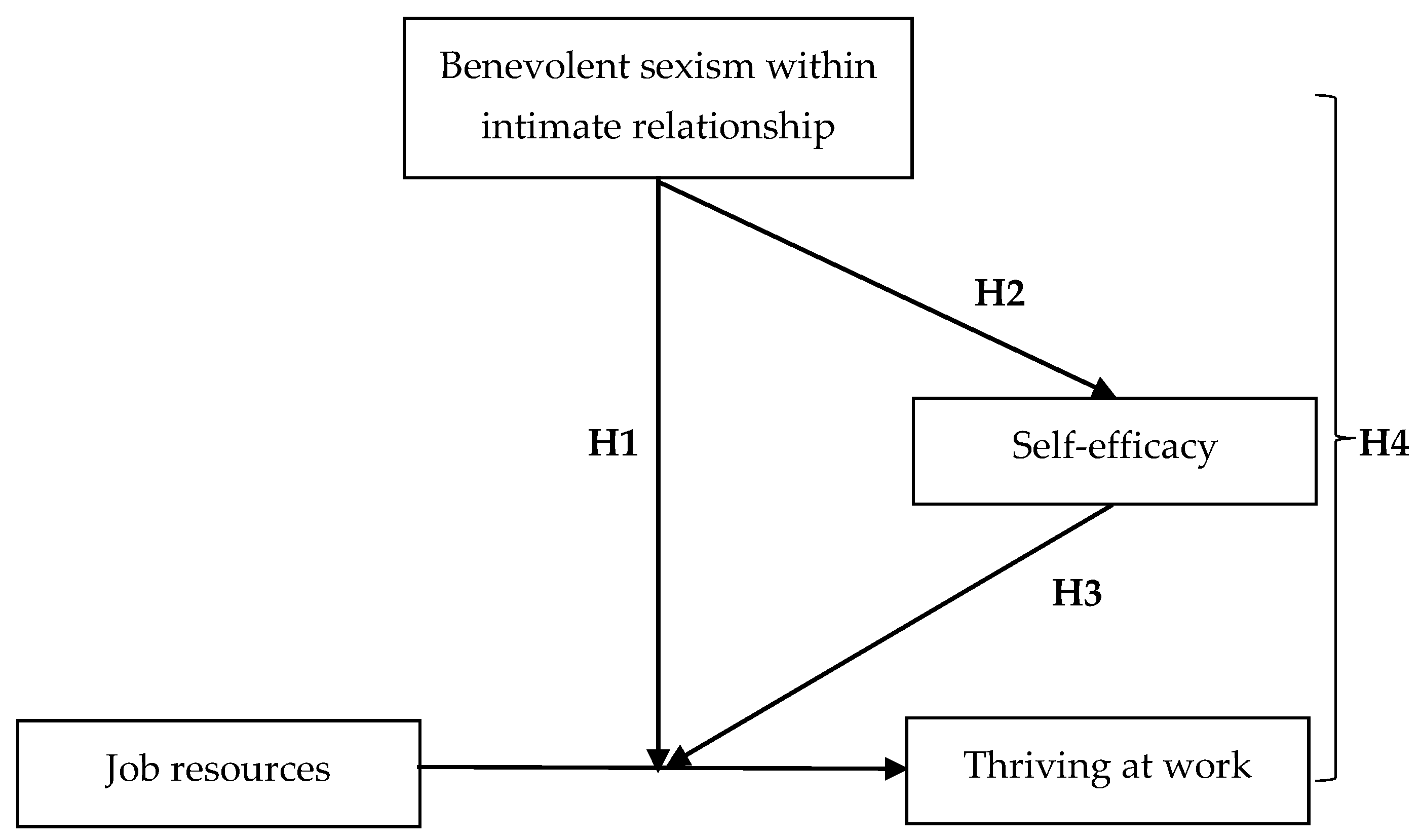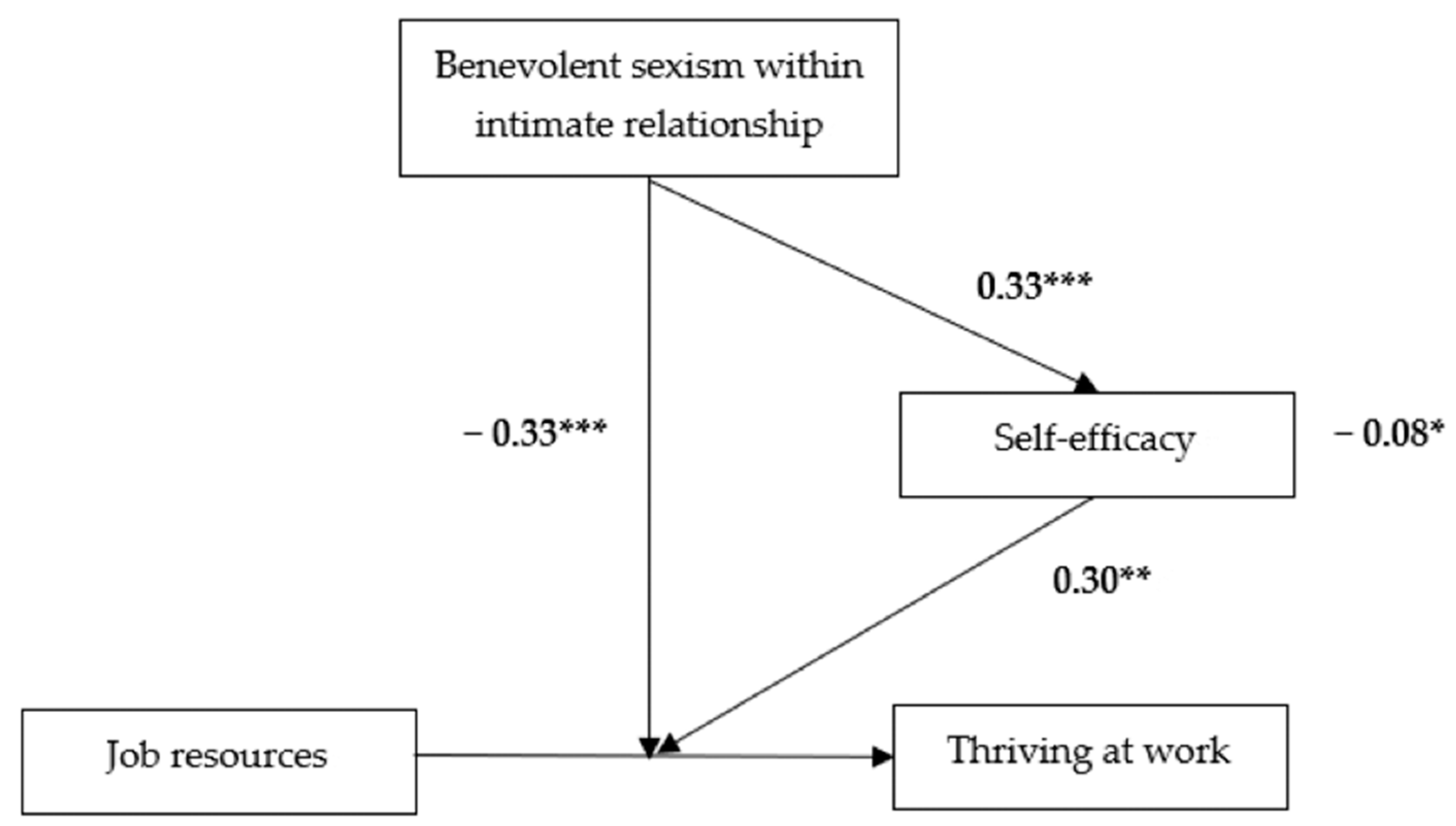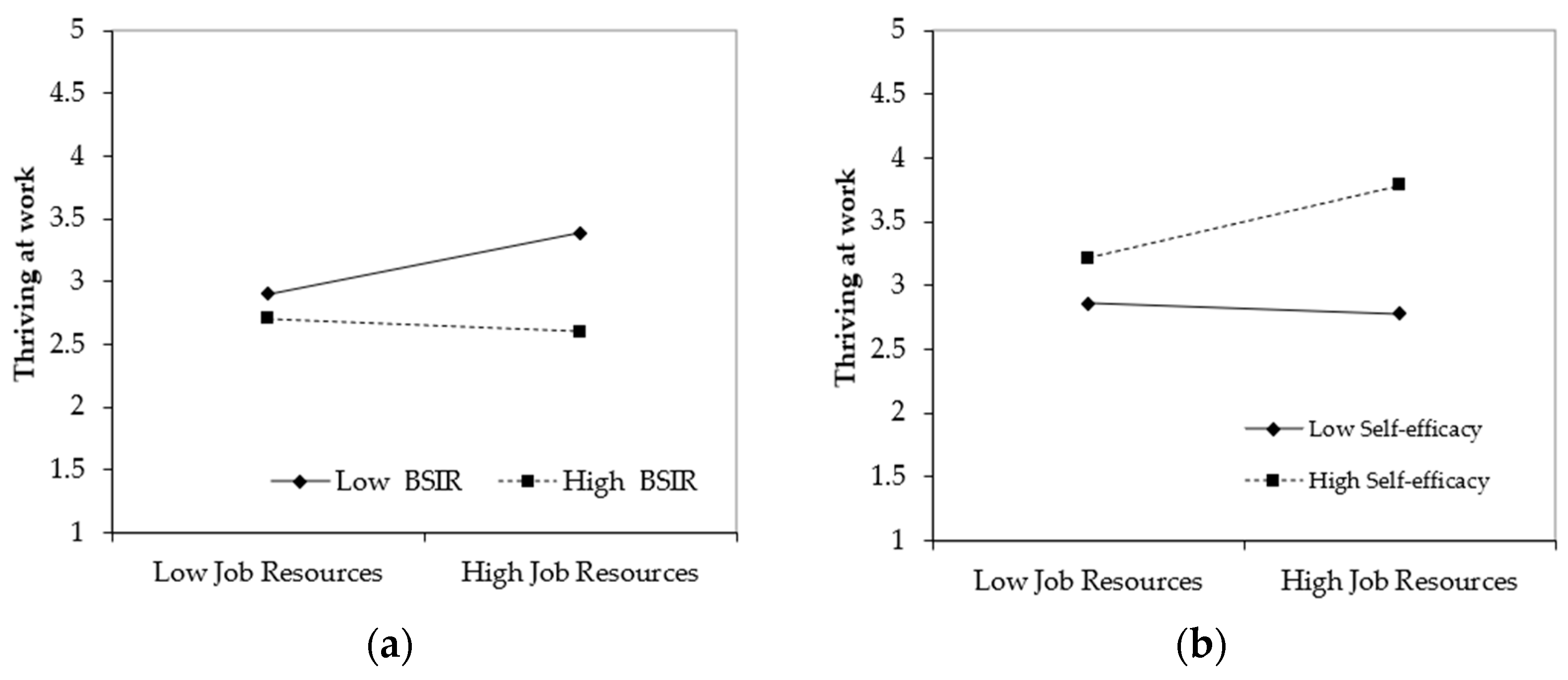Coping with Job Resources for Female Employees’ Thriving at Work: A Mediated Moderation Model of Benevolent Sexism and Self-Efficacy
Abstract
1. Introduction
2. Literature Review and Hypotheses Materials
2.1. Benevolent Sexism Within Intimate Relationships
2.2. The Mediating Role of Self-Efficacy
3. Research Methods
3.1. Sampling and Data Collection
3.2. Measures
4. Results
4.1. Measurement Model
4.2. Descriptive Statistics and Correlations
4.3. Hypothesis Testing
5. Discussion
5.1. Theoretical Contributions
5.2. Practical Implications
5.3. Limitations and Future Directions
6. Conclusions
Author Contributions
Funding
Institutional Review Board Statement
Informed Consent Statement
Data Availability Statement
Acknowledgments
Conflicts of Interest
References
- Abid, G., Ahmed, S., Fiaz Qazi, T., & Sarwar, K. (2020). How managerial coaching enables thriving at work: A sequential mediation. Journal of Entrepreneurship, Management and Innovation, 16(2), 132–160. [Google Scholar] [CrossRef]
- Alikaj, A., Ning, W., & Wu, B. (2021). Proactive personality and creative behavior: Examining the role of thriving at work and high-involvement HR practices. Journal of Business and Psychology, 36(5), 857–869. [Google Scholar] [CrossRef]
- Bai, A., Vahedian, M., Bai, M., Ghahreman, R., & Piri, H. (2024). Elevating women in the workplace: The dual influence of spiritual intelligence and ethical environments on job satisfaction. Journal of Business Management and Economic Development, 2(2), 472–490. [Google Scholar] [CrossRef]
- Bakker, A. B., & Demerouti, E. (2008). Towards a model of work engagement. Career Development International, 13(3), 209–223. [Google Scholar] [CrossRef]
- Bakker, A. B., & Demerouti, E. (2017). Job demands-resources theory: Taking stock and looking forward. Journal of Occupational Health Psychology, 22(3), 273–285. [Google Scholar] [CrossRef]
- Bakker, A. B., Demerouti, E., & Sanz-Vergel, A. I. (2014). Burnout and work engagement: The JD-R approach. Annual Review of Organizational Psychology and Organizational Behavior, 1(1), 389–411. [Google Scholar] [CrossRef]
- Bandura, A. (1977). Self-efficacy: Toward a unifying theory of behavioral change. Psychological Review, 84(2), 191–215. [Google Scholar] [CrossRef]
- Bandura, A., & Locke, E. A. (2003). Negative self-efficacy and goal effects revisited. Journal of Applied Psychology, 88(1), 87–99. [Google Scholar] [CrossRef]
- Beal, D. J., Weiss, H. M., Barros, E., & MacDermid, S. M. (2005). An episodic process model of affective influences on performance. Journal of Applied Psychology, 90(6), 1054–1068. [Google Scholar] [CrossRef]
- Boudreau, K., & Kaushik, N. (2022). Gender differences in response to competitive organization? Differences across fields from a product development platform field experiment (No. w30062). National Bureau of Economic Research. [Google Scholar]
- Brislin, R. W. (1970). Back-translation for cross-cultural research. Journal of Cross-Cultural Psychology, 1(3), 185–216. [Google Scholar] [CrossRef]
- Carlson, D. S., Thompson, M. J., Crawford, W. S., Boswell, W. R., & Whitten, D. (2018). Your job is messing with mine! The impact of mobile device use for work during family time on the spouse’s work life. Journal of Occupational Health Psychology, 23(4), 471–482. [Google Scholar] [CrossRef]
- Chan, X. W., Kalliath, T., Brough, P., O’Driscoll, M., Siu, O.-L., & Timms, C. (2017). Self-efficacy and work engagement: Test of a chain model. International Journal of Manpower, 38(6), 819–834. [Google Scholar] [CrossRef]
- Chan, X. W., Kalliath, T., Brough, P., Siu, O.-L., O’Driscoll, M. P., & Timms, C. (2016). Work-family enrichment and satisfaction: The mediating role of self-efficacy and work-life balance. The International Journal of Human Resource Management, 27(15), 1755–1776. [Google Scholar] [CrossRef]
- Chan, X. W., Kalliath, T., & Cheng, D. (2020). When the boss is blue: Examining the effects of supervisors’ negative emotions on subordinates’ cognitive work engagement and family undermining. Personnel Review, 50(2), 575–595. [Google Scholar] [CrossRef]
- Chang, W., & Busser, J. A. (2020). Hospitality career retention: The role of contextual factors and thriving at work. International Journal of Contemporary Hospitality Management, 32(1), 193–211. [Google Scholar] [CrossRef]
- Cheng, P., Shen, W., & Kim, K. Y. (2019). Personal endorsement of ambivalent sexism and career success: An investigation of differential mechanisms. Journal of Business and Psychology, 34(6), 801–815. [Google Scholar] [CrossRef]
- Connor, R. A., Glick, P., & Fiske, S. T. (2016). Ambivalent sexism in the twenty-first century. In C. G. Sibley, & F. K. Barlow (Eds.), The Cambridge handbook of the psychology of prejudice (pp. 295–320). Cambridge University Press. [Google Scholar] [CrossRef]
- Dardenne, B., Dumont, M., & Bollier, T. (2007). Insidious dangers of benevolent sexism: Consequences for women’s performance. Journal of Personality and Social Psychology, 93(5), 764–779. [Google Scholar] [CrossRef] [PubMed]
- De Clercq, D., Haq, I. U., & Azeem, M. U. (2018). Self-efficacy to spur job performance: Roles of job-related anxiety and perceived workplace incivility. Management Decision, 56(4), 891–907. [Google Scholar] [CrossRef]
- Du, D., Derks, D., & Bakker, A. B. (2018). Daily spillover from family to work: A test of the work-home resources model. Journal of Occupational Health Psychology, 23(2), 237–247. [Google Scholar] [CrossRef]
- Dumont, M., Sarlet, M., & Dardenne, B. (2010). Be too kind to a woman, she’ll feel incompetent: Benevolent sexism shifts self-construal and autobiographical memories toward incompetence. Sex Roles, 62(7–8), 545–553. [Google Scholar] [CrossRef]
- Glick, P., Diebold, J., Bailey-Werner, B., & Zhu, L. (1997). The two faces of Adam: Ambivalent sexism and polarized attitudes toward women. Personality and Social Psychology Bulletin, 23(12), 1323–1334. [Google Scholar] [CrossRef]
- Glick, P., & Fiske, S. T. (1996). The ambivalent sexism inventory: Differentiating hostile and benevolent sexism. Journal of Personality and Social Psychology, 70(3), 491–512. [Google Scholar] [CrossRef]
- Hackman, J. R. (1980). Work redesign and motivation. Professional Psychology, 11(3), 445–455. [Google Scholar] [CrossRef]
- Hackman, J. R., & Oldham, G. R. (1975). Development of the job diagnostic survey. Journal of Applied Psychology, 60(2), 159–170. [Google Scholar] [CrossRef]
- Hanek, K. J., & Garcia, S. M. (2023). Gender and competitive performance: Closing gaps with smaller competitions. Journal of Behavioral Decision Making, 36(5), e2345. [Google Scholar] [CrossRef]
- Heller, D., & Watson, D. (2005). The dynamic spillover of satisfaction between work and marriage: The role of time and mood. Journal of Applied Psychology, 90(6), 1273–1279. [Google Scholar] [CrossRef]
- Hideg, I., & Ferris, D. L. (2016). The compassionate sexist? How benevolent sexism promotes and undermines gender equality in the workplace. Journal of Personality and Social Psychology, 111(5), 706–727. [Google Scholar] [CrossRef]
- Hideg, I., & Shen, W. (2019). Why still so few? A theoretical model of the role of benevolent sexism and career support in the continued underrepresentation of women in leadership positions. Journal of Leadership & Organizational Studies, 26(3), 287–303. [Google Scholar] [CrossRef]
- Horner, M. S. (1972). Toward an understanding of achievement-related conflicts in women. Journal of Social Issues, 28(2), 157–175. [Google Scholar] [CrossRef]
- International Labour Organization. (2024). World employment and social outlook—May 2024 update. Available online: https://www.ilo.org/publications/flagship-reports/world-employment-and-social-outlook-may-2024-update (accessed on 15 February 2025).
- Jones, K., Stewart, K., King, E., Botsford Morgan, W., Gilrane, V., & Hylton, K. (2014). Negative consequence of benevolent sexism on efficacy and performance. Gender in Management: An International Journal, 29(3), 171–189. [Google Scholar] [CrossRef]
- Karasek, R., Brisson, C., Kawakami, N., Houtman, I., Bongers, P., & Amick, B. (1998). The job content questionnaire (JCQ): An instrument for internationally comparative assessments of psychosocial job characteristics. Journal of Occupational Health Psychology, 3(4), 322–355. [Google Scholar] [CrossRef]
- King, E. B., Botsford, W., Hebl, M. R., Kazama, S., Dawson, J. F., & Perkins, A. (2012). Benevolent sexism at work: Gender differences in the distribution of challenging developmental experiences. Journal of Management, 38(6), 1835–1866. [Google Scholar] [CrossRef]
- Kleine, A.-K., Rudolph, C. W., & Zacher, H. (2019). Thriving at work: A meta-analysis. Journal of Organizational Behavior, 40(9–10), 973–999. [Google Scholar] [CrossRef]
- Kosakowska-Berezecka, N., Jurek, P., Besta, T., & Badowska, S. (2017). Self-presentation strategies, fear of success and anticipation of future success among university and high school students. Frontiers in Psychology, 8, 1884. [Google Scholar] [CrossRef] [PubMed]
- Lee, T. W., & Ko, Y. K. (2010). Effects of self-efficacy, affectivity and collective efficacy on nursing performance of hospital nurses. Journal of Advanced Nursing, 66(4), 839–848. [Google Scholar] [CrossRef]
- Leicht, C., Gocłowska, M. A., Van Breen, J. A., De Lemus, S., & Randsley de Moura, G. (2017). Counter-stereotypes and feminism promote leadership aspirations in highly identified women. Frontiers in Psychology, 8, 883. [Google Scholar] [CrossRef]
- Liu, J., & Bern-Klug, M. (2013). Nursing home social services directors who report thriving at work. Journal of Gerontological Social Work, 56(2), 127–145. [Google Scholar] [CrossRef]
- Loeb, C., Stempel, C., & Isaksson, K. (2016). Social and emotional self-efficacy at work. Scandinavian Journal of Psychology, 57(2), 152–161. [Google Scholar] [CrossRef]
- Luthans, F. (2002). Positive organizational behavior: Developing and managing psychological strengths. Academy of Management Perspectives, 16(1), 57–72. [Google Scholar] [CrossRef]
- Mazzetti, G., Robledo, E., Vignoli, M., Topa, G., Guglielmi, D., & Schaufeli, W. B. (2023). Work engagement: A meta-analysis using the job demands-resources model. Psychological Reports, 126(3), 1069–1107. [Google Scholar] [CrossRef]
- Moya, M., Glick, P., Expósito, F., De Lemus, S., & Hart, J. (2007). It’s for your own good: Benevolent sexism and women’s reactions to protectively justified restrictions. Personality and Social Psychology Bulletin, 33(10), 1421–1434. [Google Scholar] [CrossRef] [PubMed]
- Muris, P. (2002). Relationships between self-efficacy and symptoms of anxiety disorders and depression in a normal adolescent sample. Personality and Individual Differences, 32(2), 337–348. [Google Scholar] [CrossRef]
- National Health Commission of the People’s Republic of China. (2023). China health statistics yearbook 2023. Available online: http://www.nhc.gov.cn/mohwsbwstjxxzx/tjtjnj/202501/b8d57baa95834269b5b3562bfec801a7/files/8d84a833f400454aa0a392856c02d558.pdf (accessed on 30 March 2025).
- Offer, S. (2014). The costs of thinking about work and family: Mental labor, work–family spillover, and gender inequality among parents in dual-earner families. Sociological Forum, 29(4), 916–936. [Google Scholar] [CrossRef]
- Oswald, D. L., Baalbaki, M., & Kirkman, M. (2019). Experiences with benevolent sexism: Scale development and associations with women’s well-being. Sex Roles, 80(5–6), 362–380. [Google Scholar] [CrossRef]
- Porath, C., Spreitzer, G., Gibson, C., & Garnett, F. G. (2012). Thriving at work: Toward its measurement, construct validation, and theoretical refinement. Journal of Organizational Behavior, 33(2), 250–275. [Google Scholar] [CrossRef]
- Rollero, C., & Fedi, A. (2014). When benevolence harms women and favours men: The effects of ambivalent sexism on leadership aspiration. Ceskoslovenska Psychologie, 58(6), 535–550. [Google Scholar]
- Rudman, L. A., & Heppen, J. B. (2003). Implicit romantic fantasies and women’s interest in personal power: A glass slipper effect? Personality and Social Psychology Bulletin, 29(11), 1357–1370. [Google Scholar] [CrossRef]
- Schaufeli, W. B., & Bakker, A. B. (2004). Job demands, job resources, and their relationship with burnout and engagement: A multi-sample study. Journal of Organizational Behavior, 25(3), 293–315. [Google Scholar] [CrossRef]
- Schwarzer, R., Bäßler, J., Kwiatek, P., Schröder, K., & Zhang, J. X. (1997). The assessment of optimistic self-beliefs: Comparison of the German, Spanish, and Chinese versions of the general self-efficacy scale. Applied Psychology, 46(1), 69–88. [Google Scholar] [CrossRef]
- Spreitzer, G., Porath, C. L., & Gibson, C. B. (2012). Toward human sustainability. Organizational Dynamics, 41(2), 155–162. [Google Scholar] [CrossRef]
- Spreitzer, G., Sutcliffe, K., Dutton, J., Sonenshein, S., & Grant, A. M. (2005). A socially embedded model of thriving at work. Organization Science, 16(5), 537–549. [Google Scholar] [CrossRef]
- Stajkovic, A. D., & Luthans, F. (1998). Self-efficacy and work-related performance: A meta-analysis. Psychological Bulletin, 124(2), 240–261. [Google Scholar] [CrossRef]
- Sun, L.-Y., Aryee, S., & Law, K. S. (2007). High-performance human resource practices, citizenship behavior, and organizational performance: A relational perspective. Academy of Management Journal, 50(3), 558–577. [Google Scholar] [CrossRef]
- Ten Brummelhuis, L. L., & Bakker, A. B. (2012). A resource perspective on the work-home interface: The work-home resources model. American Psychologist, 67(7), 545–556. [Google Scholar] [CrossRef] [PubMed]
- Umar, U. (2021). Female leadership in organisational communication perspective: A systematic literature review. Indonesian Journal of Communications Studies, 5(2), 453–470. [Google Scholar] [CrossRef]
- Vescio, T. K., Gervais, S. J., Snyder, M., & Hoover, A. (2005). Power and the creation of patronizing environments: The stereotype-based behaviors of the powerful and their effects on female performance in masculine domains. Journal of Personality and Social Psychology, 88(4), 658–672. [Google Scholar] [CrossRef]
- Walumbwa, F. O., Christensen-Salem, A., Perrmann-Graham, J., & Kasimu, P. (2020). An identification based framework examining how and when salient social exchange resources facilitate and shape thriving at work. Human Resource Development Review, 19(4), 339–361. [Google Scholar] [CrossRef]
- Xanthopoulou, D., Bakker, A. B., Demerouti, E., & Schaufeli, W. B. (2007). The role of personal resources in the job demands-resources model. International Journal of Stress Management, 14(2), 121–141. [Google Scholar] [CrossRef]



| Model | χ2 | df | χ2/df | CFI | TLI | SRMR | RMSEA |
|---|---|---|---|---|---|---|---|
| Four-factor model | 1322.95 | 983 | 1.35 | 0.91 | 0.91 | 0.06 | 0.04 |
| Three-factor model | 1832.49 | 986 | 1.86 | 0.78 | 0.77 | 0.08 | 0.06 |
| Two-factor model | 2781.44 | 988 | 2.82 | 0.53 | 0.51 | 0.13 | 0.09 |
| One-factor model | 3110.86 | 989 | 3.15 | 0.44 | 0.42 | 0.14 | 0.10 |
| Variable | M | SD | 1 | 2 | 3 | 4 | 5 | 6 |
|---|---|---|---|---|---|---|---|---|
| 1. Age | 32.51 | 6.72 | ||||||
| 2. Tenure | 9.03 | 6.55 | 0.72 ** | |||||
| 3. Job demands | 3.35 | 0.87 | 0.01 | −0.03 | ||||
| 4. Job resources | 3.95 | 0.64 | 0.18 * | 0.17 * | 0.36 ** | |||
| 5. BSIR | 3.66 | 0.70 | 0.05 | 0.02 | 0.18 ** | 0.05 | ||
| 6. Self-efficacy | 3.59 | 0.85 | −0.12 | −0.04 | 0.25 ** | 0.19 ** | −0.23 ** | |
| 7. Thriving at work | 3.38 | 0.82 | 0.02 | 0.11 | 0.23 ** | 0.26 ** | −0.28 ** | 0.50 *** |
| Thriving at Work | Self-Efficacy | |||||||||||
|---|---|---|---|---|---|---|---|---|---|---|---|---|
| MODEL1 | MODEL2 X → Y | MODEL3 X, W → Y | MODEL4 X, M → Y | MODEL5 X, W, M → Y | MODEL6 W → M | |||||||
| Variable | Estimate | SE | Estimate | SE | Estimate | SE | Estimate | SE | Estimate | SE | Estimate | SE |
| Constant | 2.90 *** | 2.23 *** | 3.60 *** | 0.98 *** | ||||||||
| Age | −0.02 | 0.01 | −0.02 | 0.01 | −0.01 | 0.01 | −0.01 | 0.01 | −0.01 | 0.01 | −0.02 | 0.01 |
| Tenure | 0.03 * | 0.01 | 0.02 | 0.01 | 0.02 | 0.01 | 0.02 | 0.01 | 0.02 | 0.01 | 0.01 | 0.01 |
| JD | 0.23 ** | 0.08 | 0.16 * | 0.08 | 0.22 ** | 0.07 | 0.08 | 0.07 | 0.12 | 0.07 | 0.29 *** | 0.08 |
| JR | 0.25 *** | 0.07 | 0.15 | 0.08 | 0.19 ** | 0.07 | 0.14 | 0.07 | ||||
| BSIR | −0.35 *** | 0.07 | −0.19 * | 0.08 | ||||||||
| JR × BSIR | −0.33 ** | 0.11 | −0.20 | 0.11 | ||||||||
| S. Eff | 0.40 *** | 0.06 | 0.34 *** | 0.07 | ||||||||
| JR ×S.Eff | 0.30 ** | 0.09 | 0.25 ** | 0.08 | ||||||||
| R2 | 0.08 | 0.11 | 0.24 | 0.34 | 0.35 | |||||||
| ΔR2 | 0.03 | 0.16 | 0.26 | 0.27 | ||||||||
| F | 5.94 ** | 6.03 ** | 10.63 ** | 17.34 ** | 13.46 ** | |||||||
Disclaimer/Publisher’s Note: The statements, opinions and data contained in all publications are solely those of the individual author(s) and contributor(s) and not of MDPI and/or the editor(s). MDPI and/or the editor(s) disclaim responsibility for any injury to people or property resulting from any ideas, methods, instructions or products referred to in the content. |
© 2025 by the authors. Licensee MDPI, Basel, Switzerland. This article is an open access article distributed under the terms and conditions of the Creative Commons Attribution (CC BY) license (https://creativecommons.org/licenses/by/4.0/).
Share and Cite
Chang, P.-C.; Liu, S.; Guo, Y.; Cai, Q. Coping with Job Resources for Female Employees’ Thriving at Work: A Mediated Moderation Model of Benevolent Sexism and Self-Efficacy. Behav. Sci. 2025, 15, 640. https://doi.org/10.3390/bs15050640
Chang P-C, Liu S, Guo Y, Cai Q. Coping with Job Resources for Female Employees’ Thriving at Work: A Mediated Moderation Model of Benevolent Sexism and Self-Efficacy. Behavioral Sciences. 2025; 15(5):640. https://doi.org/10.3390/bs15050640
Chicago/Turabian StyleChang, Po-Chien, Shuyue Liu, Yuanli Guo, and Qihai Cai. 2025. "Coping with Job Resources for Female Employees’ Thriving at Work: A Mediated Moderation Model of Benevolent Sexism and Self-Efficacy" Behavioral Sciences 15, no. 5: 640. https://doi.org/10.3390/bs15050640
APA StyleChang, P.-C., Liu, S., Guo, Y., & Cai, Q. (2025). Coping with Job Resources for Female Employees’ Thriving at Work: A Mediated Moderation Model of Benevolent Sexism and Self-Efficacy. Behavioral Sciences, 15(5), 640. https://doi.org/10.3390/bs15050640






